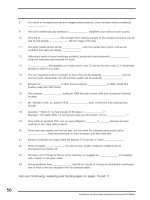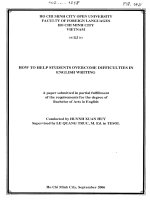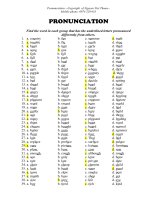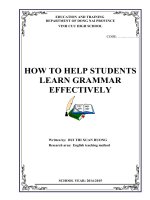HOW TO TEACH AND LEARN ENGLISH VOCABULARY FOR GRADE 6, 7 TO HELP STUDENTS EFFECTIVVELY COMMUNICATE
Bạn đang xem bản rút gọn của tài liệu. Xem và tải ngay bản đầy đủ của tài liệu tại đây (98.72 KB, 14 trang )
THANH HOA EDUCATION AND TRAINING DEPARTMENT
INITIATIVE
HOW TO TEACH AND LEARN ENGLISH VOCABULARY
FOR GRADE 6, 7 TO HELP STUDENTS EFFECTIVELY
COMMUNICATE
Performer: Nguyen Thi Lan
Position: Teacher
Working place: Ly Tu Trong Junior High School
Experience innovation of subject: English
THANH HOA, 2019
TABLE OF CONTENTS
1
Page
3
Content
I-INTRODUCTION.............................3
5-6
II-RATIONALE AND STATE OF THE PROBLEM........................5
1. Rationale....................................................5
2. Current status of the problem.................6
7-11
III - PROBLEM SOLVING........................7
1. Steps and measures implemented in each class
1.1. Teaching vocabulary skills learned
1.2. Consolidation from a number of other activities in class
1.3. To foster vocabulary learning methods for students
12
2. Achievements....................................................12
13
IV-SOME LESSONS LEARNED FROM REALITY.....................13
14
V. CONCLUSION..............................14
THEMES
HOW TO TEACH AND LEARN ENGLISH VOCABULARY FOR
GRADE 6, 7 TO HELP STUDENTS EFFECTIVELY COMMUNICATE
I-INTRODUCTION :
School year 2005-2006 was the last year of the renewal of general school
program under the Directive No. 14/2001/CT-TTG dated June 16 th, 2001 of
Prime Minister and Resolution No. 40/2000/QH10 of the Congress on the
2
renewal of general education on the following aspects: content - textbooks,
teaching methods, teaching means to evaluate the quality of students.
Innovative teaching method plays an important role to the success of education
innovation. Reforming teaching method can be understood as: "Promoting a
positiveness, self-discipline, activeness and creativity of students in accordance
with the characteristics of each class, subject, fostering self-learning method;
training skills to apply knowledge in practical, emotional impact, bring joy,
excitement for student learning”. (Article 24 - Education Law).
To do this, teachers must teach in an innovative way towards promoting a
positiveness of students as well as organize, guide students to explore, discover
and occupy knowledge.
It is necessary for students to innovate their learning method so that they can
self-study, self-discovery, self-resolve problems, dominate knowledge, exercise
creatively independent thinking.
Besides flexible coordination between traditional teaching methods and
modern ones, teachers need to choose appropriate forms of teaching method for
each individual, group, class or organize educational games...
Moreover, foreign language requires students to grasp basic, minimal and
relative knowledge of the system of modern English practice to be suitable with
each students. This subject also equips skills for student in order to use English
as a communication tool. For students of grade 6, 7 – who initially get
acquainted with junior school and with foreign language (English) with images
and learning method which are different from the ones at primary school.
Learning and practice foreign language are effective only when learners
can make communication well. The communication depends on many factors in
the process of learning foreign language such as smoothly practicing listening,
speaking, reading and writing skill. In order to complete these skills, learners
must grasp grammar of that language. Moreover, the potential vocabulary ought
to be enough to communicate with people who know that language, especially
with native people. Therefore, teachers and students need to determine that
3
understanding and using language in learning foreign language are very
important, but vocabulary is more important than that. Communication is
considered effective when language, tone, syllable are correct, understand the
content and topic in order to attract listeners.
Closely related to the correct pronunciation of the word, it is stress, the last
syllable of the word and many consecutive consonants in one syllable. In
addition, words in the sentence must be used in appropriate context, so it
requires students to have knowledge about the culture, customs and traditions of
that country. The communicators will face disadvantages when use the words
with wrong semantic in wrong context, leading to unexpected isunderstandings,
or disruption in business, politics, etc. Conversely, the communicators will be
successful if they use the correct words, even florid and smooth words which
satisfying listeners will have a strong impact to the emotion of the people who
are communicating. The big question is how learners can better their vocabulary,
pronunciation and use accurate words in each semantic situation and each
context. It seems that the question is easy to answer; in fact, it poses difficulty to
all those who are teaching and learning foreign languages in general and English
subject in particular subjects.
To solve the above problems, in the range of this topic I am pleased to
present the teaching – learning method of English vocabulary in grade 6, 7 to
help students communicate effectively.
II-RATIONALE AND STATE OF THE PROBLEM
1. Rationale :
The 4th Central Resolution session 7 (1993) gave the mission "Renewing
teaching methods at all levels of education" and identified "Encouraging selflearning", to "apply modern education methods to foster student’s capacity for
creative thinking and problem solution."
The 2nd Central Resolution Session 8 (12-1996) further confirmed "It is
necessary to innovate education and training methods, overcoming a one-way
path to indoctrinate, training creative thinking for students. Gradually apply
4
advanced methods and modern facilities in the teaching process, ensuring
conditions and self-study time for student".
Article 28 of the Education Law (2005) writes: General education
methods ought to promote positiveness, self-discipline, ativeness and creativity
of students in line with the characteristics of each class, subject, fostering selflearning method, etc and training skills into practical".
The objective of English subject in junior school is to establish and
develop essential knowledge, basic skills of English and intellectual qualities for
students to continue higher learning and come to life.
2. Current status of the problem :
* The situation of students learning foreign language (English) at Ly Tu Trong
Junior High school.
Through the teaching process, through interschool professional activities
and through discussions with colleagues, I myself realized that learning English
situation revealed some disadvantages as following:
- For the students:
+ Overall, students are "scared" and "hesitant" to learn new words, the use of
words shows many limitations such as misspellings, incorrect pronunciation,
inaccurate use of words, inconsistent with the context. Most of students just
have a habit of memorizing simple word or its meaning.
+ Some students just learn-by-heart to deal with writing new words on the
board, after that, they immediately forget how to use those words. Some students
try to memorize all the new words so when they face too much new words, they
will be in the fear of learning them. That is the reason why students often do not
learn anymore or study yet ineffective. The main culprit of the above problem is
that students do not know how to learn vocabulary, not to find out an appropriate
method to learn vocabulary.
- For the teacher:
+ The fact of vocabulary teaching and learning in Ly Tu Trong Junior High
school attracts lots of concern of English teachers. A few years ago, teachers
5
were really embarrassing when teaching vocabulary lessons. They can be taught
if there are dozens of words in a unit with the ignorance of the relevance
between words and theme of the lesson, mood of students, even application of
the words in communication.
+ Recent 4 years, the movements on reforming foreign language teaching
has been implemented, teachers have been trained techniques in teaching
vocabulary. In fact, teachers have remained embarrassing for using such
techniques when they want to give a hint through furniture, to give example or
to explain the word briefly and easily to understand, particularly abstract nouns.
+ Selecting vocabulary to teach in a review lesson weighs a burden on
teachers, so they forget to make use of lessons which can review vocabulary.
Incorrect pronunciation is a sad reality for students, leading to difficulties in
communication, even changing the teacher of each subject in each academic
year. I also want to mention to previously incorrect pronunciation of a few
teachers and most of students. From the above problems, I need to spend much
time on preparing documents and finding methods to teach vocabulary, making
students interested in learning vocabulary in particular and in learning English in
general.
* Status of learning foreign language (English) at Ly Tu Trong Junior High
school in particular:
- The issues on the way to teach vocabulary to make students interested in
learning vocabulary in particular and learning English in general is also clearly
expressed in the process of teaching and learning English of teachers and
students of Ly Tu Trong Junior high school.
- The initial survey to test vocabulary learning using in communication of
students of Ly Tu Trong Junior school:
From the 5th week of the first semester, I had a talk with the students to
conduct a small survey for my grade to determine whether students learn,
pronounce and use words to communicate at which level, and errors they often
make to find solutions.
6
+ Here is the conversation used to examine and the issues are drawn from
this survey:
* Survey Conversation 1
- T: What’s this (Teacher shows students a waste basket).
- S1: /weis beiskit/
- S2: /weis beikits/
- S3: /weis beiskits/
-> 3 students answer correctly when they identify objects and object's name in
English, but they pronounce wrongly and most of them do not pay attention to
the sound / s /, the correct pronunciation is / Weist bæskit /.
III-PROBLEM SOLVING :
1. Steps and measures implemented in each class
1.1. Teaching vocabulary by learned skills :
Vocabulary is one of the most important parts of learning foreign
language. If you want to better your English, in any skills: listening, speaking,
reading or writing, we also need a certain vocabulary. This vocabulary does not
come suddenly, it is a long lasting process of accumulation.
Teaching vocabulary according to trained procedures is not easy. Teachers must
adhere to the principles of word suggestion: brief, understandable and attractive.
Curiosity of students is increasing as teachers create interesting situations along
with embedding the word. To ensure those word suggestion principles, teachers
have to spend a lot of time on preparing lesson documents, teaching tools as
well as situation question suggestion carefully. Students must also prepare for
the lesson at home, such as: learn vocabulary by using dictionaries and learn the
reading content by their own ways to understand.
Teachers have to teach words which are used several times in class, closed
to the subject that students are learning and applied to communicate. Words for
teaching must be chosen carefully and belong to: active vocabulary, not taught
from spreading and imposing. The number of words is moderate (5-8 words); if
the amount of words is too much, teachers need a little activity done in about 2-3
7
minutes to guess words from context with the appropriate form of exercise.
Students can learn more about the lesson content without feeling boring or
stressful.
Unit 2 - A closer look 1 (English class: 6)
The theme of related words is Road signs and rules of the road. Teacher’s
selected words are popular and close to students. Preparing for teaching:
- Word suggestion (the technique used to introduce words)
- Teaching tools (cards, sub board)
- The card to practice sounds (/ z /, / t /, / s /)
- Techniques to review word (check vocabulary)
- The number of words selected: 7 word
+ dangerous (a): (translation)
+ (to) go fast (antonym) opposite
+ an accident: (picture)
with “slow down”
+ an intersection: (B. picture)
+ (to) warn us (realia)
+ (to) slow down (mime) (T plays + (to) help us (translation)
in a motorcyciler’s role)
As for preparation teaching documents, teachers need to prepare necessary
utensils such as picturesque about 1 crash, a teacher must draw a street
intersection in the fastest way in order to not waste time: teachers can write a
card of words to save time from writing on the board and removing words in the
process of teaching vocabulary.
Review vocabulary: wordsquares
- Sub board will be prepared economically, and one more sub board to write the
answer of vocabulary review.
- To make sure students read well, the teacher let them read the word without
sample and edit wrong sounds when using cards / s / / z / / t /
Unit 3: A closer look 1 (English class: 6)
Preparation:
* Number of words to be taught in the subject: Body
Head
shoulder
hands
feet
toes
8
Chest
arms
legs
finger
* Teachers use the technique named "mime" to teach those nouns. Teachers can
use the body pictures but I want to use this image in "check vocabulary".
- The items are prepared: 9 word cards, an image of human body.
- Training sound card / s / / z / / st /
Teachers use 9 cards to "check vocabulary" as well as using combining
procedure between words and body parts on drawings.
Unit 11: (English class: 6)
This is the lesson contained lots of vocabulary. Vocabulary themed "thing to
buy" and (number) "quantifiers" and "containers" has 17 words. With 7 selected
words to teach themed "thing to buy", I prepare for the activity as following:
- some eggs (picture)
- some beef (realia)
- some chocolates (realia)
- some soap (realia)
- some oil (picture)
- some tooth paste (B picture)
Supplies: - 7 word cards / card fix: / s / / st / / z /
- Chocolate, beef, soap bar
- Images: 12 eggs, cooking oil bottle
In addition, teachers should draw a toothpaste with 1 small tube of cream to
be put out to save time. I can use real objects to teach but I draw to make the
lesson more attractive for suggestions as well as creating excitement for
students.
The number of remaining words can not be ignored because they are used
to say the measurement unit or container objects, the number of remaining (10
words), I let students work in 2-3 minutes to match words with objects
After connecting, teachers let students read the word to practice pronunciation,
moreover, teachers should pay attention to linking syllables /græmz ar / /three (r)
ar / ... When students pronounced correctly, they are completely confident to
communicate and attract the listener.
Unit 12: (English class: 6)
9
Spring
Warm
Summer Hot
Fall
Cool
Winter
Cold
The
theme of vocabulary in this lesson is weather and seasonal temperatures,
selected words: 8 words written on cards
Preparation:
- 8 word cards (additional 2 cards: cold, hot)
- 4 paintings of 4 seasons
- 1 trained sound card / SPR /
+ the spring (picture)
+ the summer (picture)
+ the fall (picture)
+ the winter (picture)
+ the seasons (example: the spring, summer, winter, fall, are…)
+ warm (opposite with cold)
+ cold (opposite with hot)
To remember vocabulary, students will be practiced with exercises "pelmanism"
b) Consolidation by other activities in the class
Word consolidation aims to help students remember words by themselves,
pronounce more accurately, use words better in communication. Word
memorizing in the lesson or revision words according to family words, topics
through different activities in many different tricks: Bingo, brainstorm, chain
game, crossword puzzles, dictation, hangman, Jumbled worlds, Kim's game,
lucky numbers, matching, chill mime, realia drill, drill picture, networks,
noughts & crosser, gap fill, vocabulary ordering, pelmanism, what & where, rub
out and remember, simon saids, slap the board, shark attack, snakes & ladders,
wordsquare, substitution boxes.
Teachers can use these procedures in accordance with activities in one
class, including: warm up, checking vocabulary, vocabulary for further exercise.
c) To foster vocabulary learning methods for students
* Which words need to be learnt?
10
For students, English words can be divided into 3 groups:
- Unnecessary words
- Words using only in reading and listening
- Words must be used
Students do not need to learn unnecessary words. For words using only in
reading or listening, students just know their meaning. For words must be used,
students should learn systematically. Students should:
* Pay attention not only to word’s meaning but also spelling, pronunciation,
word usage and determining the kind of word.
* Buy a dictionary with moderate number of words, easy to learn.
* Think of an image related to the word when learning new words so that
students can quickly remember its meaning. Sometimes while learning new
words, students will meet others word with the same meaning, they also need to
review and give the comparison between words.
* Learn vocabulary frequently, at everywhere, every time with many different
forms at school as well as at home. Students should arrange the number of
words for an appropriate amount of time given, aiming to help students
remember, review the word before learning other words.
* Have a notebook to take note words, the teacher can periodically collect to
give additional points.
2. Achievements
In 2017-2018 academic year, I was assigned to teach English for grade 6, 7.
Through teaching and practical learning of students, I found that students
understand and make use of words as well as supplement more words into their
vocabulary.
Through comparison the academic performance of students in grades 6B
where I taught, the quality before implementing the topic can be seen:
Total
34
pretty good
No.
%
medium
No.
%
weak
No.
%
less
No.
%
10
27
7
0
0
29,4
79,4
20,6
11
After applying the method of developing thematic vocabulary in each lesson
(Applying theme), the results of several test reach higher. Specifically:
Total
pretty good
No.
%
medium
No.
%
weak
No.
%
less
No.
%
34
15
44,1
29
85,3
5
14,7
0
0
From the above results, we can see that the application of vocabulary teaching
methods in grade 6, 7 promotes effectively and positively in improving the
quality of teaching and gives students a necessary vocabulary to enhance
communication skills of students.
IV- LESSONS LEARNED FROM REALITY
* Through practical teaching vocabulary in grades 6, 7 and the achievement, I
myself have precious experiences as following
- Teaching vocabulary in grades 6, 7 is an urgent need to frequently use and
effectively promote. On the other hand, it not only applies in Reading lesson but
also in: writing, listening, speaking.... not only for English grade 6, 7 but also for
the program in grade 8, 9.
- Teaching words is used after the Warm-up before a lesson. Therefore,
teachers need to carefully study words and use procedures in a flexible manner,
in order to help students guess the word, to know how to read word, write down
and remember word, apply to situations in the sentence.
* In the process of teaching, teachers need to give suggestions, guidance and
inspiration to students as well as remind students to prepare for the lesson
specifically.
- Frequently motivate and encourage students with limited vocabulary to
participate in group activities, creating comfortable psychology and opportunity
for them.
- To take full advantages of comments of experts, of the team, the
professional group to find out suitable solutions, applying effectively in
teaching. To give students chance to practice vocabulary, teachers should
enhance the visual forms such as: paintings with simples drawing (picture black
board), combining various colors to make students more interested in learning
12
English, students desires to learn, to know and to communicate English in the
lesson.
V. CONCLUSION :
Innovation of teaching methods is a very important task in the renewal
strategy of education sector. The target of teaching English in particular has
contribute to promote positiveness, creative thinking of students in learning.
Through this manipulation, students explore and learn the lesson by themselves
more carefully.
As a teacher I always wish to bring students with attractive lessons,
creating favorable conditions for them to learn well.
These are my thoughts and my work in the teaching process which I boldly
made, when presented in this chapter, there remains many deficiencies which are
not scientific and tight. I look forward to receiving comments from colleagues
about my topic to help me better in teaching. From bottom of my heart, I want to
say Thank you sincerely and promise to try my best in teaching.
Thanh Hoa, March 20th, 2019
Confirmation of Head
I here by declare that this is my
experience innovation, not copying
from other people's content.
Written by
Nguyen Thi Lan
13
REFERENCES
1. Age education newspaper No 5 (1/11/2003).
2. Education magazine No. 43/2002.
3. Teaching English - Trainer's handbook. (Author Adrian Daff).
4. Psychology documents for secondary school students (Compiled by World
School. Published by Hanoi National University, 1998).
5. Education Law: the National Political Publishing - Ha Noi/2006
6. Document on training Legal Education in 2006 by the Department of
Education and Training of Quang Binh.
7. Regular refresher material for English teachers cycle 3 (2004-2007)
Educational Publishers.
14









